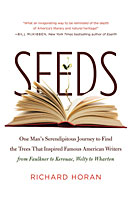sierraclub.org - sierra magazine - may/june 2011 - mixed media
Last Chance for the Gulf | Earth Beat
TREE HUGGING 101
Inspiration from our rooted colleagues
Trees are a prophet's and poet's go-to muse. Grab the nearest Bartlett's Familiar Quotations and browse the "Tree" section and you'll see what I mean. Or go to literaryseeds.typepad.com and check out all the famous quotes about trees. That will prove the poet part. As for how trees inspired the prophets, you'll need to expend a little more energy. —Richard Horan
Back in the 1970s, Kenyan Wangari Maathai, winner of the 2004 Nobel Peace Prize, had an epiphany about trees. She realized that the solution to her fellow African villagers' persistent scarcity of food, shelter, and firewood was to plant them. Thus was born the BILLION TREE CAMPAIGN. Because of her initiative, 11 billion seedlings have been planted worldwide as of 2009. If you'd like to help out, there's an iPhone app for that. Maathai's GREEN BELT MOVEMENT works to combat the challenges of deforestation, soil erosion, and a lack of water and puts underemployed African women to work. Read Maathai's memoir, UNBOWED (Knopf, 2006), or, for kids, Donna Jo Napoli's MAMA MITI: WANGARI MAATHAI AND THE TREES OF KENYA (Simon and Schuster, 2010).
The handiest and dandiest field guide of all time is David Allen Sibley's SIBLEY GUIDE TO TREES (Alfred A. Knopf, 2000), which was lauded by E. O. Wilson, Pulitzer Prize-winning author of The Naturalist. To keep your kit more compact, check out the iPhone apps MyNature Tree Guide and AUDUBON TREES: A FIELD GUIDE TO NORTH AMERICAN TREES.
Trees have always inspired, and they've always begged to be climbed. Richard Preston tells the story of a group of young, intrepid tree climbers who discovered an as-yet-unnamed 378-foot-tall redwood in California's Redwood National Park in his entertaining THE WILD TREES: A STORY OF PASSION AND DARING (Random House, 2007). The more prudent among us can spend hours wandering around trees online at the National Register of Big Trees. To find the biggest, tallest, and oldest in your neck of the woods, check out Barbara Bosworth's TREES: NATIONAL CHAMPIONS (MIT Press, 2005).
Philosopher Jiddu Krishnamurti had an epiphany under a California pepper tree in 1922. Located at his Ojai, California, retreat, the ancient Schinus molle now lies on its side, its gray innards exposed to the elements. For details, read Mary Lutyen's biography of K (as his followers refer to him), THE YEARS OF AWAKENING (Shambhala, 1975). Fictional, but no less an apotheosis of man and tree, is Jean Giono's transcendent masterpiece THE MAN WHO PLANTED TREES (Chelsea Green, 1985), an allegory of a French Johnny Appleseed reforesting the Alps. An animated short film based on the book won an Oscar in 1987. Of course, the most famous prophet-tree combo story is of an ascetic named Siddhartha Gautama, who wandered into the Indian hamlet of Bodh Gaya and sat in meditation under the Bodhi tree, resolving not to move until he'd attained nirvana.
To experience trees as an art form, go to "PORTRAITS OF TREES," an exhibition of sculptural, hypnotic photographs by Tom Zetterstrom. Or pore over two inspiring coffee-table books: Jenny Linford's THE TREE: WONDER OF THE NATURAL WORLD (Barnes and Noble Books, 2006) and Lewis Blackwell's THE LIFE AND LOVE OF TREES (Chronicle Books, 2009). But perhaps the best way to experience trees is simply to take a walk in the woods.
Excerpt From Richard Horan's Seeds: One Man's Serendipitous Journey to Find the Trees That Inspired Famous American Writers From Faulkner to Kerouac, Welty to Wharton (Harper Perennial, 2011):

I threw caution to the wind and started spearing a little circle around one of the seedlings with my ignition key, like a golfer fixing a divot on the putting green. It was at that point that a ranger appeared from out of nowhere.
"Collecting mementos?"
"Those are deodar cedars," he said, hunkering down on his haunches next to me, gingerly caressing the little seedling with his fingers. He stood up and pointed. "The parent tree is right over there." He was a short, middle-aged man, dark haired, with a clerk's complexion but a scientist's expression.
"Did John Muir plant these trees?" I asked somewhat boldly, beginning to think I was not going to be issued a citation.
"Some of them. This bay tree here was, and the cedars, too; the parents of the sapling you're digging up. But most of the other trees are second generation."
He scratched his jaw and tilted his head. "You know if you're going to dig up seedlings . . ." (I felt a citation coming) ". . . there are some older ones under the parent trees." . . .
"Make sure you take some of the soil away with them; that'll help them grow." He stood and smiled at me. It was the purest smile I'd ever seen. "Enjoy yourselves," he said, and off he went.
Richard Horan is the author of several novels, including Goose Music (Steerforth, 2001). He lives in Oswego, New York.